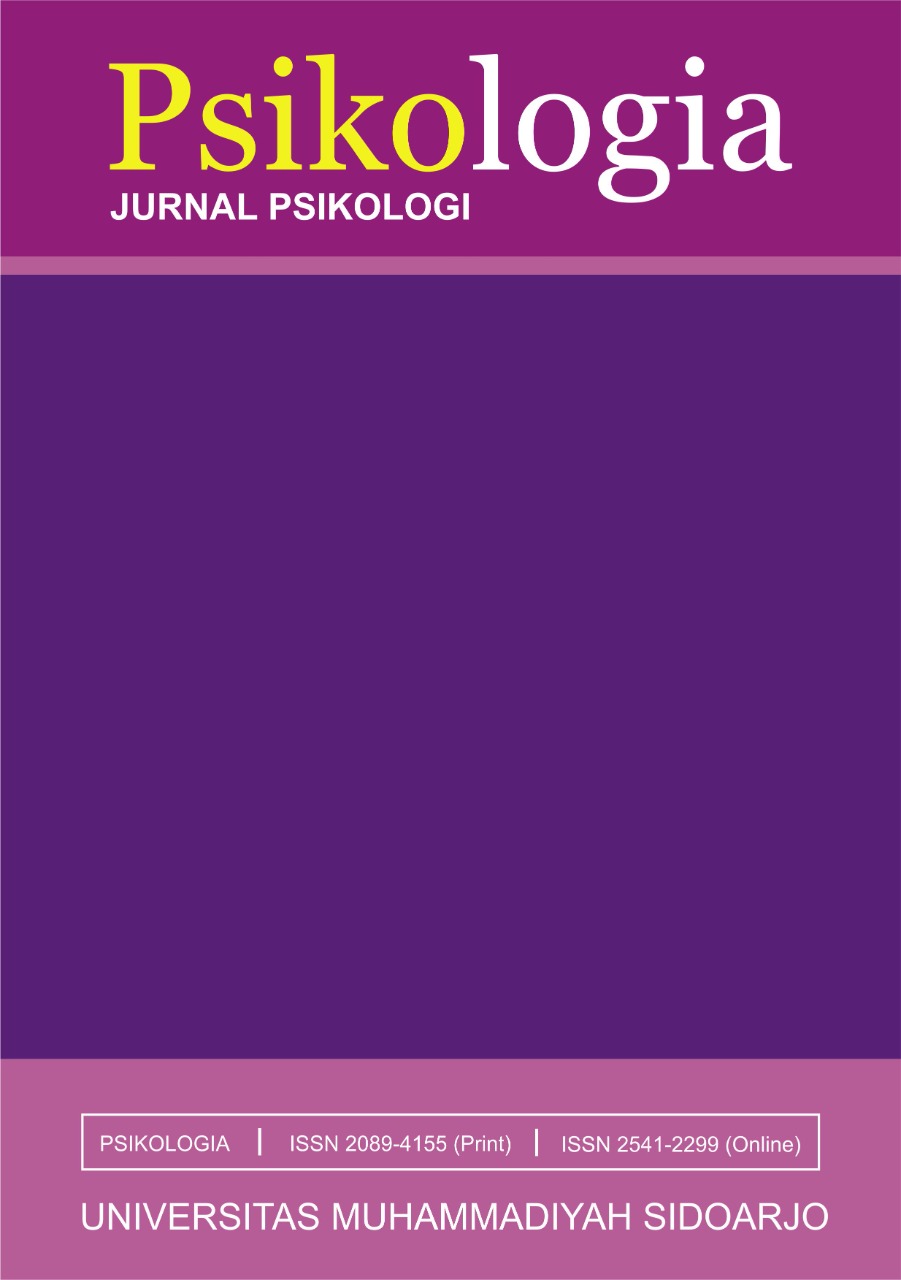Self Disclosure of College Students who use Instagram Second Account Based on Interpersonal Trust
Self Disclosure Mahasiswi Pengguna Second Account Instagram Berdasarkan Interpersonal Trust
DOI:
https://doi.org/10.21070/psikologia.v10i1.1848Keywords:
Interpersonal Trust, Second Account Instagram, Self DisclosureAbstract
Second accounts are additional social media profiles used by individuals to share content separate from their primary accounts, typically comprising followers who are close acquaintances and mutually trust each other. Consequently, users of second accounts engage in self-disclosure, whereby they reveal personal information to their followers. The objective of this study is to examine the relationship between interpersonal trust and self-disclosure among female college students who use second accounts on Instagram. The research population consists of female students in Jember, with a sample size of 274 individuals selected through purposive sampling. The study employed the interpersonal trust scale adapted from Asmaini (2020) and the self-disclosure scale adapted from Arwa (2021). The findings reveal a significant positive correlation between interpersonal trust and self-disclosure (r=.490; p<.05), indicating that higher levels of interpersonal trust are associated with increased self-disclosure among female college students who use second accounts on Instagram. Students who trust their second account followers tend to feel comfortable and relatively more open in disclosing various aspects of themselves.
Highlights:
- Trust fosters openness – Higher interpersonal trust leads to greater self-disclosure among second account users.
- Selective audience – Second accounts are primarily followed by close, trusted acquaintances.
- Significant correlation – Study confirms a strong positive relationship (r=.490; p<.05) between trust and self-disclosure.
Keywords: Interpersonal Trust, Second Account Instagram, Self Disclosure
References
Andrian, B., Endang SM, A., & Octaviani, V. (2022). Self Disclosure Analysis of Second Instagram Account Users Among Students of Dehasen University Bengkulu. Jurnal ISO: Jurnal Ilmu Sosial, Politik Dan Humaniora, 2(1), 55–60. https://doi.org/10.53697/iso.v2i1.658
Ardiesty, M., Arindawati, W., & Nayiroh, L. (2022). Jurnal Ilmu Pengetahuan Sosial Motif Dan Makna Second Account Instagram Bagi Mahasiswa Di Kota Karawang 1. Nusantara: Jurnal Ilmu Pengetahuan Sosial, 9(8), 3118–3126. http://jurnal.um-tapsel.ac.id/index.php/nusantara/index
Boer, P. Y., & Pratama, M. (2022). Hubungan Antara Trust Dengan Self Disclosure Pada Remaja Putri Pengguna Tiktok. Jurnal Psikologi Jambi, 7(02), 32–38. https://doi.org/10.22437/jpj.v7i02.22455
Dewi, S. P. (2016). Perbedaan Perilaku Merokok Ditinjau Dari Tingkat Stres Pada Wanita Dewasa Awal Di Yogyakarta. 107. https://digilib.uns.ac.id/dokumen/detail/29876/Perbedaan-Perilaku-Merokok-Ditinjau-Dari-Tingkat-Stres-Pada-Wanita-Dewasa-Awal-Di-Yogyakarta
Dwiputra, F. (2018). Hubungan Antara Motif Afektif Penggunaan Social Media Twitter Dengan Keterbukaan Atas Informasi. Universitas Brawijaya Malang
Fauzia, A. Z., Maslihah, S., & Ihsan, H. (2019). Pengaruh Tipe Kepribadian Terhadap Self-Disclosure Pada Dewasa Awal Pengguna Media Sosial Instagram Di Kota Bandung. Journal of Psychological Science and Profession, 3(3), 151. https://doi.org/10.24198/jpsp.v3i3.23434
Firual, A. R., & Hariyadi, S. (2022). Pengaruh Interpersonal Trust dan Intimate Friendship Terhadap Self-Disclosure Generasi Z Pengguna Twitter. Journal of Social and Industrial Psychology, 11(1), 44–52. https://doi.org/10.15294/sip.v11i1.61552
Fitriyani, N., Fridha Tri Palupi, M., & Insan Romadhon, M. (2022). Makna Kepemilikan Second Account pada Pengguna Instagram (Studi Fenomenologi Mahasiswa Ilmu Komunikasi Universitas 17 Agustus 1945 Surabaya).
Fontaine, L. (2019). Fear of Missing Out = Missing Out. Design Journal, 22(sup1), 2167–2168. https://doi.org/10.1080/14606925.2019.1595457
Gainau, M. B. (2009). Keterbukaan Diri (Self Disclosure) Siswa Dalam Perspektif Budaya Dan Implikasinya Bagi Konseling. Jurnal Ilmiah Widya Warta, 33(1), 95–112
Hulukati, W., & Djibran, M. R. (2018). Analisis Tugas Perkembangan Mahasiswa Fakultas Ilmu Pendidikan Universitas Negeri Gorontalo. Bikotetik (Bimbingan Dan Konseling Teori Dan Praktik), 2(1), 73. https://doi.org/10.26740/bikotetik.v2n1.p73-80
Hurlock, E, B. (2009). Psikologi Perkembangan Suatu Pendekatan Sepanjang Rentang Kehidupan (edisi ke – 5). Jakarta: Erlangga
Misykatin Idham, N. D. (2023). Pinisi: Journal of Teacher Professional Pengaruh Kepercayaan Interpersonal Terhadap Pengungkapan Diri pada Remaja Akhir Pengguna Media Sosial Instagram. 4(2022), 96–104. https://ojs.unm.ac.id/TPJ
Permana, I. P. H., & Sutedja, I. D. M. (2021). Analisis Perilaku Pengguna Akun Kedua Di Media Sosial Instagram. Jurnal Inovasi Penelitian, 2(4), 1195–1204. https://stp-mataram.ejournal.id/JIP/article/view/838
Pramesti, C. S. L., & Dewi, D. K. (2022). Pengaruh Anonimitas Terhadap Self Disclosure Pada Generasi Z Di Twitter. Character: Jurnal Penelitian Psikologi, 9(5), 51–64. https://ejournal.unesa.ac.id/index.php/character/article/view/47347
Prihantoro, E., Damintana, K. P. I., & Ohorella, N. R. (2020). Self Disclosure Generasi Milenial melalui Second Account Instagram. Jurnal Ilmu Komunikasi, 18(3), 312. https://doi.org/10.31315/jik.v18i3.3919
Punyanunt-Carter, Narissra. (2006). An analysis of college students' self-disclosure behaviors on the Internet. College Student Journal. 40. 329-331.
Qadri, M. (2020). Pengaruh Media Sosial Dalam Membangun Opini Publik. Qaumiyyah: Jurnal Hukum Tata Negara, 1(1), 49–63. https://doi.org/10.24239/qaumiyyah.v1i1.4
Ratnasari, R., Hayati, E. N., & Bashori, K. (2021). Self Disclosure Media Sosial pada Fase Kehidupan Dewasa Awal. Jurnal Diversita, 7(2), 141–147. https://doi.org/10.31289/diversita.v7i2.4511
Rotenberg, K. J. (Ed.). (2010). Interpersonal trust during childhood and adolescence. Cambridge University Press. https://doi.org/10.1017/CBO9780511750946
Sarasati, F., Olivia, H., & Sudarsono, A. B. (2022). Penggunaan Fitur Close Friends Instagram Sebagai Media Pengungkapan Diri Pada Generasi Z. J-IKA: Jurnal Ilmu Komunikasi Fakultas Ilmu Komunikasi Universitas BSI Bandung, 9(2), 92–99. https://doi.org/10.31294/kom.v9i2.14267.g5758
Tazkia, N. S., & Nawangsih, E. (2021). Hubungan Interpersonal Trust dengan Self disclosure pada Mahasiswa Pengguna Aplikasi Tinder. Prosiding Psikologi, 7(1), 42–46.
Waasi, I., Widiastuti, M., & Safitri, M. (2021). Pengaruh Tipe Kepribadian Terhadap Self-Disclosure Pada Pengguna Instagram. JCA Psikologi, 2(1), 19–27.
Vijayakumar, N., & Pfeifer, J. H. (2020). Self-disclosure during adolescence: exploring the means, targets, and types of personal exchanges. Current Opinion in Psychology, 31, 135–140. https://doi.org/10.1016/j.copsyc.2019.08.005
WHEELESS, L. R., & GROTZ, J. (1976). Conceptualization and Measurement of Reported Self‐Disclosure. Human Communication Research, 2(4), 338–346. https://doi.org/10.1111/j.1468-2958.1976.tb00494.x
Willems, Y. E., Finkenauer, C., & Kerkhof, P. (2020). The role of disclosure in relationships. Current Opinion in Psychology, 31, 33–37. https://doi.org/10.1016/j.copsyc.2019.07.032
Yulianti, A. (2015). Emosional Distress dan Kepercayaan Terhadap Pasangan yang Menjalani Commuter Marriage. Seminar Psikologi & Kemanusian, 978–979.






